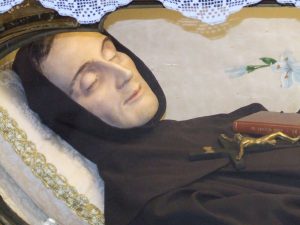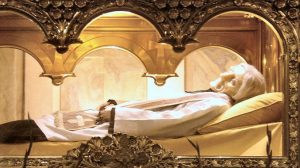
Incorruptibility, the miraculous preservation of the bodies of saints after death, has been a fascinating phenomenon in the Catholic Church for centuries. These bodies remain intact, often with a lifelike appearance, defying the natural process of decay.
Incorruptibility is considered a sign of divine intervention and a testament to the sanctity of the individuals concerned. In this article, we will explore the concept of incorruptible bodies and share a few examples of saints whose remains can still be seen today.
Understanding Incorruptible Bodies
 The phenomenon of incorruptible bodies is not unique to the Catholic Church, as it has been reported in other religious traditions as well. However, it has been particularly associated with Catholic saints, who are believed to have led exceptionally holy lives. Incorruptibility is often viewed as a sign of divine favor and evidence of the saint’s close relationship with God.
The phenomenon of incorruptible bodies is not unique to the Catholic Church, as it has been reported in other religious traditions as well. However, it has been particularly associated with Catholic saints, who are believed to have led exceptionally holy lives. Incorruptibility is often viewed as a sign of divine favor and evidence of the saint’s close relationship with God.
It is essential to note that incorruptibility is not the same as the preservation of relics. While relics are venerated by the faithful, incorruptible bodies are considered miraculous in and of themselves. Furthermore, incorruptibility is not a requirement for canonization, though it has sometimes been considered as supporting evidence of a saint’s holiness.
Here are some examples of the most well-known Incorruptible Saints:
St. Bernadette Soubirous

St. Bernadette Soubirous, the young visionary who experienced the Marian apparitions at Lourdes, France, died in 1879. When her body was exhumed in 1909, it was found to be incorrupt. Today, her remarkably well-preserved remains are displayed in a glass reliquary at the Chapel of St. Bernadette in Nevers, France. Pilgrims from around the world visit the shrine to venerate St. Bernadette and seek her intercession.
St. Catherine Labouré

St. Catherine Labouré, a French nun who received the Miraculous Medal vision from the Virgin Mary, passed away in 1876. When her body was exhumed in 1933, it was discovered to be incorrupt. St. Catherine’s body now rests in a glass casket at the Chapel of Our Lady of the Miraculous Medal in Paris, France, where it can be viewed by visitors.
St. John Vianney

St. John Vianney, also known as the Curé of Ars, was a humble parish priest in France known for his dedication to his parishioners and his gift of healing. He died in 1859, and his body was found incorrupt when it was exhumed in 1904. St. John Vianney’s body is displayed in a glass case in the Basilica of Ars, France, which remains a popular pilgrimage site.
St. Vincent de Paul

St. Vincent de Paul, the French priest renowned for his charitable works and dedication to the poor, died in 1660. His body, found to be incorrupt, is preserved in a glass reliquary at the Church of St. Vincent de Paul in Paris, France. Visitors can pay their respects and seek inspiration from the saint who devoted his life to the less fortunate.
A Testament to Sanctity
Incorruptible bodies are a powerful reminder of the divine mysteries that surround the lives of the saints.These miraculous occurrences inspire the faithful, reinforcing the belief in the sanctity of those who dedicated their lives to God. Incorruptibility serves as a testament to the profound spiritual connection between the saint and the divine.


